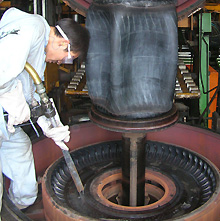This article needs additional citations for verification. (April 2008) |

Dry-ice blasting is a form of carbon dioxide cleaning, where dry ice, the solid form of carbon dioxide, is accelerated in a pressurized air stream and directed at a surface in order to clean it.[1][2]
The method is similar to other forms of media blasting such as sand blasting, plastic bead blasting, or sodablasting in that it cleans surfaces using a medium accelerated in a pressurized air stream, but dry-ice blasting uses dry ice as the blasting medium. Dry-ice blasting is nonabrasive, non-conductive, nonflammable, and non-toxic.
Dry-ice blasting is an efficient[3][verification needed] cleaning method. Dry ice is made of reclaimed carbon dioxide that is produced from other industrial processes, and is an approved media by the EPA, FDA and USDA. It also reduces or eliminates employee exposure to the use of chemical cleaning agents.
Compared to other media blasting methods, dry-ice blasting does not create secondary waste or chemical residues as dry ice sublimates, or converts back to a gaseous state, when it hits the surface that is being cleaned. Dry-ice blasting does not require clean-up of a blasting medium.[4] The waste products, which includes just the dislodged media, can be swept up, vacuumed or washed away depending on the containment.
- ^ Máša, Vítězslav; Horňák, David; Petrilák, Dalimil (December 2021). "Industrial use of dry ice blasting in surface cleaning". Journal of Cleaner Production. 329: 129630. Bibcode:2021JCPro.32929630M. doi:10.1016/j.jclepro.2021.129630.
- ^ Kohli, Rajiv (2019). "Applications of Solid Carbon Dioxide (Dry Ice) Pellet Blasting for Removal of Surface Contaminants". Developments in Surface Contamination and Cleaning: Applications of Cleaning Techniques. pp. 117–169. doi:10.1016/B978-0-12-815577-6.00004-9. ISBN 978-0-12-815577-6.
- ^ Jet, Cold. "Dry Ice Blasting and Dry Ice Production Equipment by Cold Jet". coldjet.com. Retrieved 10 July 2018.
- ^ "Apex Dry Ice Blasting: Industrial Services – Akron, Ohio". apexdryiceblasting.com. Retrieved 11 July 2018.